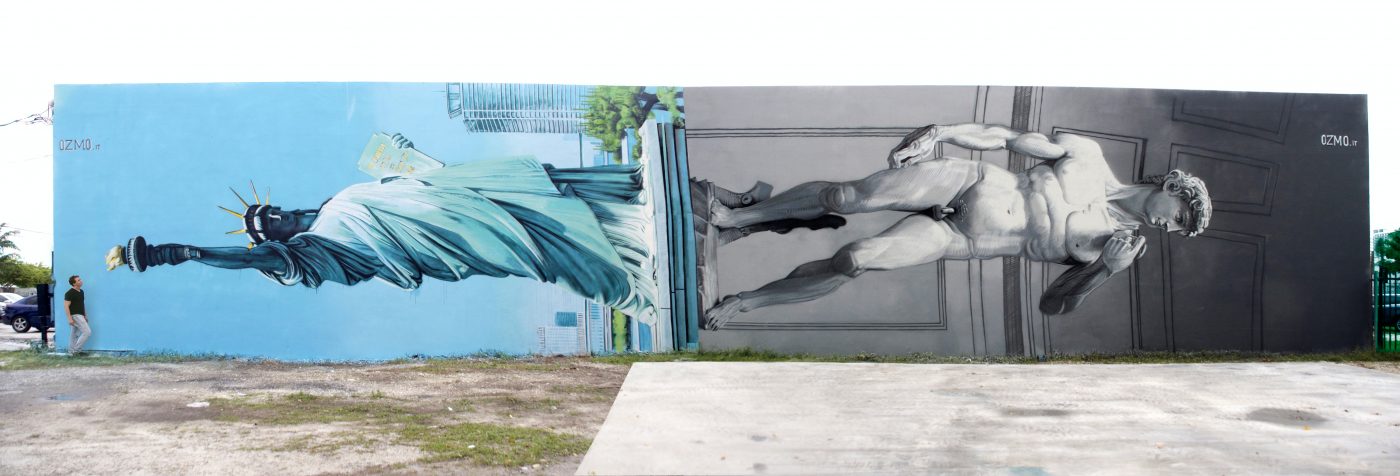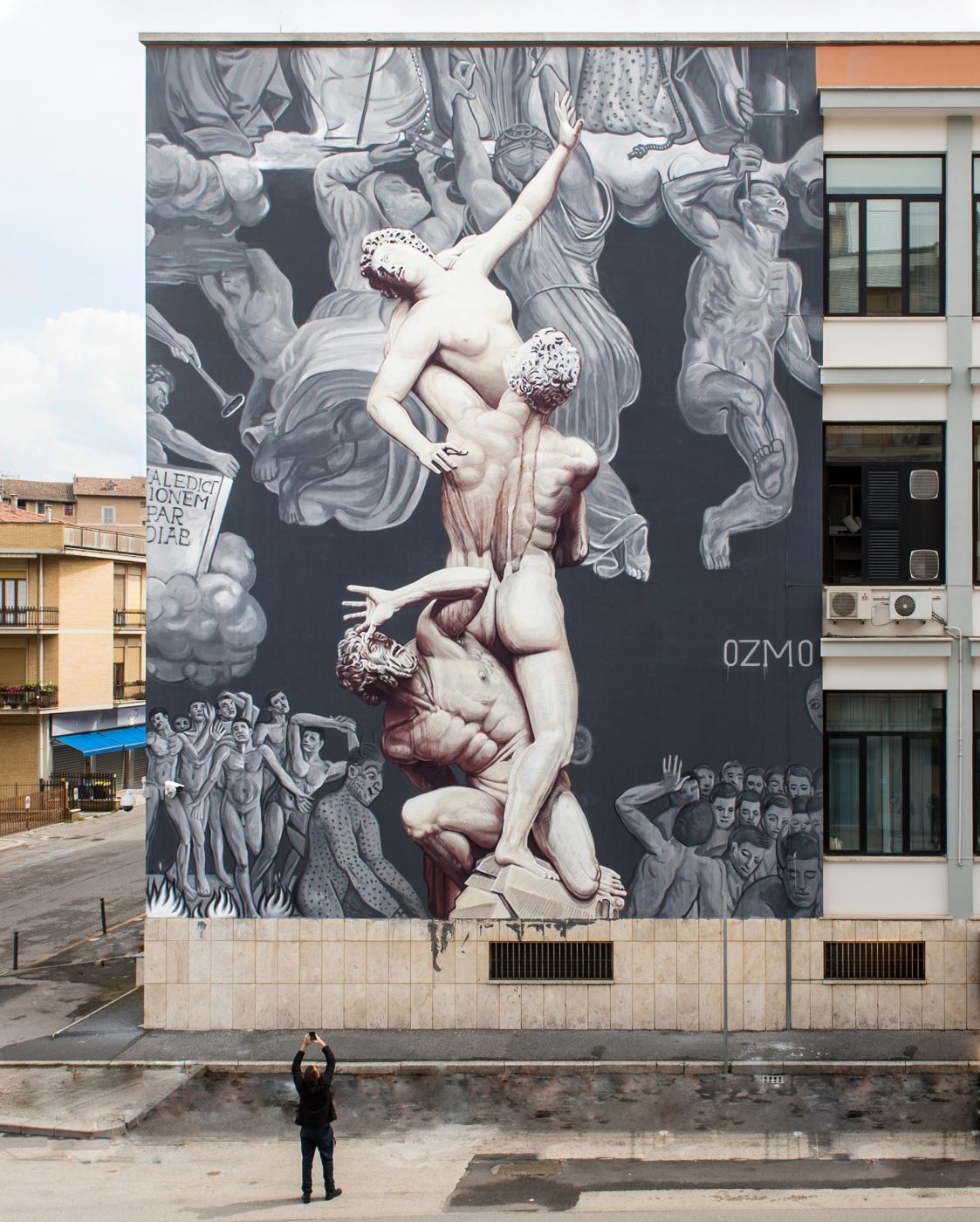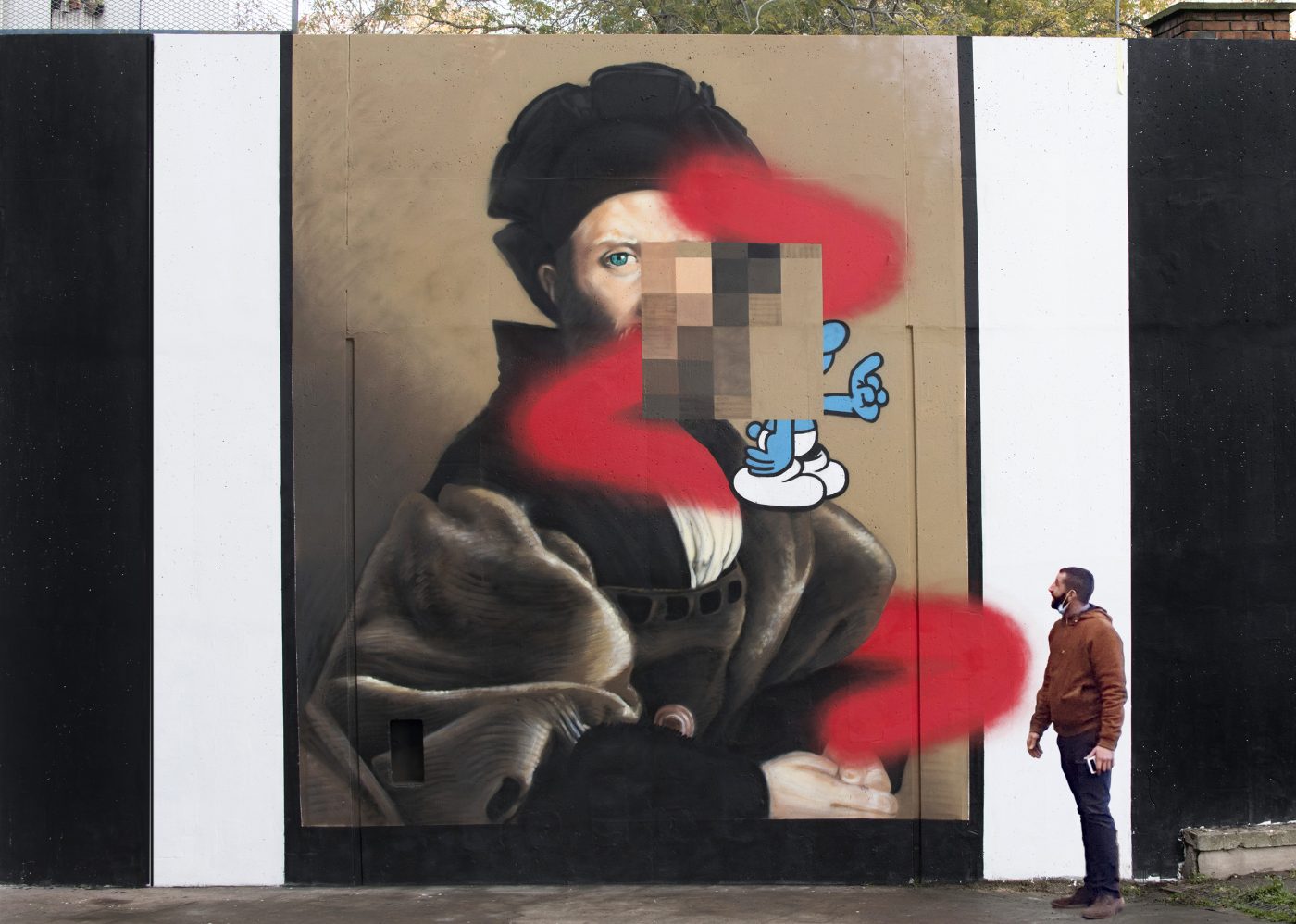



Artist-in-Residence 2023
Der italienische Pionier der Urban Art Szene Ozmo überbrückt erfolgreich die Kluft zwischen Street Art und Museen. Er verwebt geschickt kulturelle Bezüge in seiner Arbeit und mischt klassische und historische Bildmotive mit zeitgenössischen Elementen. Seine kühnen und fesselnden Wandgemälde laden Betrachter dazu ein, gesellschaftliche Normen zu hinterfragen. Ozmos ortsspezifische Installationen fordern die Wahrnehmung heraus und erkunden soziale, kulturelle, politische und traditionelle Bräuche. Indem er künstlerische Grenzen neu definiert, bringt er eine frische und innovative Haltung in Galerien und Institutionen ein. Mit seiner Arbeit nimmt Ozmo Einfluss auf die gesamte künstlerische Landschaft.
Ozmo, the pioneering Italian urban artist, has successfully bridged the gap between street art and museums. He skillfully intertwines cultural references through his work, blending classical and historical imagery with contemporary elements. His bold and captivating murals invite viewers to question societal norms. Ozmo’s site-specific installations challenge perception, exploring social, cultural, political, and traditional customs. By redefining artistic boundaries, he injects a fresh and innovative attitude into galleries and institutions. As an influential figure in the underground scene and contemporary art, Ozmo’s impact resonates throughout the artistic landscape.
Descriptions:
Lady Liberty and David share the same Pedestal
Ozmo arrives in the Wynwood area of Miami for a personal interpretation of one of the symbols of the United States put in a hypothetical comparison, or on the same level, to one of the most representative works of Italy and Italian art in general: the David by Michelangelo. With the iconic title „Lady Liberty and David sharing the same Pedestal“, the work divides the wall in two by showing us in opposite directions the Statue of Liberty and the David of Buonarroti, enriched by their respective scenery, the skyline, and the New York sky, the gallery of the Academy of Florence. In both cases, the figures are literally lying on the ground. In both cases, they stand as ramparts from a common pedestal, the people. The work, carried out through the usual working capacity „site-specific“ represents the opportunity for a 360º reflection on the relationship between the States and our country, The points common, going so far as to touch by comparison the pedestal different and subjective domains. Ozmo teases our strings by posing doubts and perplexities in offering us once again the opportunity of a different and multiform reading. The analogy of the pedestal and the relationship between the two works manages to trigger certainly different reflections, thus focusing on the equalities but above all on the diversities of the two states and cultural and social inheritances. The author plays with the two symbols by opposing them, the ideal of freedom of the United States juxtaposed to the hero represented by Michelangelo, digging deeper the first is the symbol of the industrial revolution, and its subsequent development, while the former stands as a symbol of the Renaissance and art, and still emigrants against tourists for a cauldron of thoughts and ideas that invest those who observe the work.
Let the Trumpets Blow
Ozmo realized this big work dedicated to the city (16 x 10 meters), able to dialogue with historical memories and artistic of the territory. Inspired by the fresco of the Torresani brothers, the artist managed to capture the fatigue and suffering with which the saints commit themselves to save the souls. In the Rat of the Sabines of Giambologna, Ozmo, on the contrary, grasped the violence and the drama of a kidnapping, the power contained in young bodies, and the surrender of a senile body, on whose shoulders not only years but also all the evils and anxieties of the human race. At the sound of the trumpets, the time will be over and justice will make its way, allowing the ascent of the one who goes to salvation, favoring the fall of the one who will see in the condemnation his own destiny. While drawing inspiration from the past, from two similar but profoundly different, gifts of salvation one, gift of slavery the other, To the Let the Trumpets Blow is a work more timely than ever, which reminds all of us of the time that passes and the inevitable exhaustion of the possibilities of remedying the errors committed, not only in the individual sphere but also on a global scale. The work dialogue deeply with the context, notably because it is performed on the wall of the court of the city, the first institutional intervention of its kind in Italy by an urban artist.
Baldassare, pixelated with smurf
The work was rewarded by the association GEMELLARTE, with the exchange of artists who intervened in the city of Saint-Ouen in France and in the city of Terni in Italy. The theme of this edition ‚The Renaissance‘ in the Covid virus epidemic, a fresco inspired by Il Cortegiano, Raffaello Sanzio’s portrait of Baldassare Castiglione, a leading Renaissance intellectual and theorist of the cultural evolution of Italian courts, especially at the court of Elisabetta Gonzaga in Urbino. A masterpiece of this success that even François I, king of France, was impressed with, and had it reproduced and distributed to each of his courtesans: hence the common thread between Italy and France. I then imagined a reinterpretation of «Il Cortegiano» with the addition of layers that interact with others, opening up new semantic and conceptualmeanings to the original work.
Black Hercules – Turning Venus
This series of large drawings (150×150 max 200×200) pastel on canvas and paper continues my exploration of concepts of Classic and Canon, digested by intelligence artificial. There are various networked AI programs, where to insert a description of an image to have a or several proposals for formalization by the program. The scope of my research in particular, such as often in the past, reconnects to the tradition of the history and use of images, often sacred or mythological filtered by classical heritage. That’s why my keywords started from reinterpretations of the artistic intelligence of the classics ( in the text I insert I choose terms like: classical, statue, surreal, sexy, Canova, Hellenistic, Apollo, Venus, etc.) I find interesting the results where one can glimpse the beauty of forms reinterpreted by the limits of the instrument: the figures have often distorted face, sometimes several members appear, and other elements disappear or are underlined, often forms become ambiguous, for example by representing both drapery and a limb.
Where:
26.07. – 13.08.2023
Kunstresidenz – Artist-in-Residence
THE COMODO, Kaiserhofstraße 18
Instagram:
www.instagram.com/ozmone
Web:
www.ozmo.it
